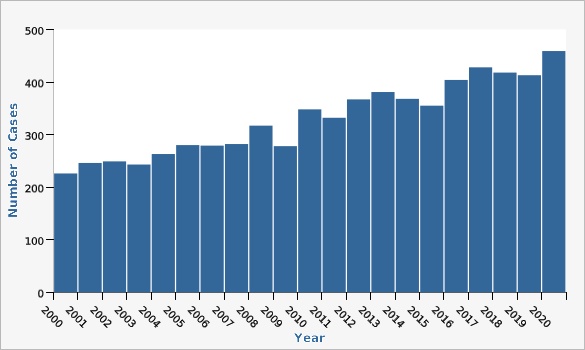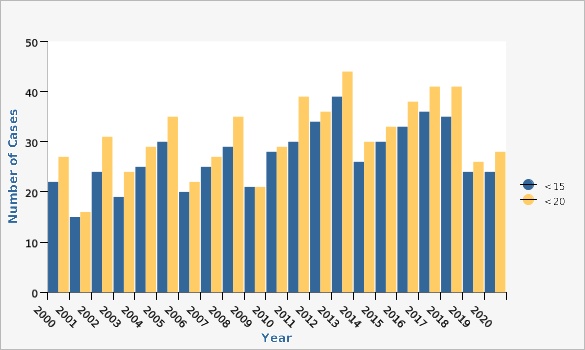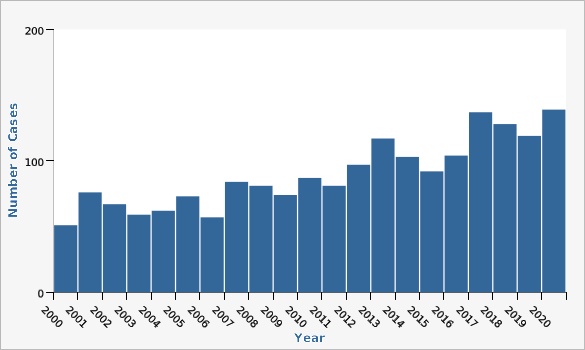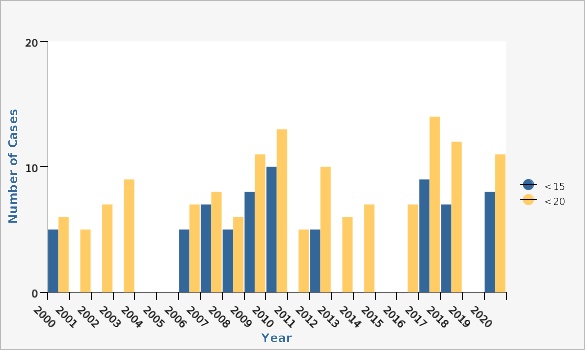Complete Health Indicator Report of Leukemias
Definition
The rate of leukemia (ICD-10: C91-C95) in Utah per 100,000 population.Numerator
The number of new leukemia cancers diagnosed among Utah population for a given time period (ICD-10: C91-C95).Denominator
Population of Utah for a specific period of time.Data Interpretation Issues
Cancer diagnoses in 2020 may be impacted by the COVID-19 pandemic due to the changes in health services and cancer screening accessibility.Why Is This Important?
Leukemia is a cancer of the blood-forming cells. Leukemia starts in the bone marrow and then spreads to the blood. Not all leukemias are the same. Leukemias are divided into four main types based whether it is acute (fast growing) or chronic (slower growing) and whether it starts in myeloid cells or lymphoid cells. Leukemia occurs most commonly in older adults, but acute lymphocytic leukemia (ALL) is the most common cancer in children.^1^ Some risk factors for developing some types of leukemia include smoking, environmental exposures to chemicals such as benzene, radiation exposure, prior cancer treatment, blood problems, viral infections, and genetics.[[br]] [[br]] ---- 1. [https://seer.cancer.gov/statfacts/html/leuks.html]What Is Being Done?
The Utah Leukemia and Lymphoma Society offers many services to those affected by these cancers such as educational information, support groups, advocacy and volunteer opportunities, treatment options, and research information. For more information visit [http://www.lls.org/].Related Indicators
Related Relevant Population Characteristics Indicators:
Graphical Data Views
Leukemia Number of Cases by Year, Utah, 2000-2020

| Year | Number of Cases | |||||
|---|---|---|---|---|---|---|
Record Count: 21 | ||||||
| 2000 | 226 | |||||
| 2001 | 246 | |||||
| 2002 | 249 | |||||
| 2003 | 243 | |||||
| 2004 | 263 | |||||
| 2005 | 280 | |||||
| 2006 | 279 | |||||
| 2007 | 282 | |||||
| 2008 | 317 | |||||
| 2009 | 278 | |||||
| 2010 | 348 | |||||
| 2011 | 332 | |||||
| 2012 | 367 | |||||
| 2013 | 381 | |||||
| 2014 | 368 | |||||
| 2015 | 355 | |||||
| 2016 | 404 | |||||
| 2017 | 428 | |||||
| 2018 | 418 | |||||
| 2019 | 413 | |||||
| 2020 | 459 | |||||
Data Notes
Numbers include standard categories of Lymphocytic Leukemia, Myeloid Leukemia, Monocytic Leukemia, and Other Leukemia.Data Source
Cancer data provided by the Utah Cancer Registry, supported by the National Cancer Institute (HHSN261201800016I), the U.S. Center for Disease Control and Prevention (NU58DP0063200), the University of Utah, and Huntsman Cancer FoundationLeukemia: Acute Lymphocytic Number of Cases in Children (<15 and <20 years) by Year, Utah, 2000-2020

| Age <15 vs <20 | Year | Number of Cases | ||||
|---|---|---|---|---|---|---|
Record Count: 42 | ||||||
| <15 | 2000 | 22 | ||||
| <15 | 2001 | 15 | ||||
| <15 | 2002 | 24 | ||||
| <15 | 2003 | 19 | ||||
| <15 | 2004 | 25 | ||||
| <15 | 2005 | 30 | ||||
| <15 | 2006 | 20 | ||||
| <15 | 2007 | 25 | ||||
| <15 | 2008 | 29 | ||||
| <15 | 2009 | 21 | ||||
| <15 | 2010 | 28 | ||||
| <15 | 2011 | 30 | ||||
| <15 | 2012 | 34 | ||||
| <15 | 2013 | 39 | ||||
| <15 | 2014 | 26 | ||||
| <15 | 2015 | 30 | ||||
| <15 | 2016 | 33 | ||||
| <15 | 2017 | 36 | ||||
| <15 | 2018 | 35 | ||||
| <15 | 2019 | 24 | ||||
| <15 | 2020 | 24 | ||||
| <20 | 2000 | 27 | ||||
| <20 | 2001 | 16 | ||||
| <20 | 2002 | 31 | ||||
| <20 | 2003 | 24 | ||||
| <20 | 2004 | 29 | ||||
| <20 | 2005 | 35 | ||||
| <20 | 2006 | 22 | ||||
| <20 | 2007 | 27 | ||||
| <20 | 2008 | 35 | ||||
| <20 | 2009 | 21 | ||||
| <20 | 2010 | 29 | ||||
| <20 | 2011 | 39 | ||||
| <20 | 2012 | 36 | ||||
| <20 | 2013 | 44 | ||||
| <20 | 2014 | 30 | ||||
| <20 | 2015 | 33 | ||||
| <20 | 2016 | 38 | ||||
| <20 | 2017 | 41 | ||||
| <20 | 2018 | 41 | ||||
| <20 | 2019 | 26 | ||||
| <20 | 2020 | 28 | ||||
Data Source
Cancer data provided by the Utah Cancer Registry, supported by the National Cancer Institute (HHSN261201800016I), the U.S. Center for Disease Control and Prevention (NU58DP0063200), the University of Utah, and Huntsman Cancer FoundationLeukemia: Acute Myeloid Number of Cases by Year, Utah, 2000-2020

| Year | Number of Cases | |||||
|---|---|---|---|---|---|---|
Record Count: 21 | ||||||
| 2000 | 51 | |||||
| 2001 | 76 | |||||
| 2002 | 67 | |||||
| 2003 | 59 | |||||
| 2004 | 62 | |||||
| 2005 | 73 | |||||
| 2006 | 57 | |||||
| 2007 | 84 | |||||
| 2008 | 81 | |||||
| 2009 | 74 | |||||
| 2010 | 87 | |||||
| 2011 | 81 | |||||
| 2012 | 97 | |||||
| 2013 | 117 | |||||
| 2014 | 103 | |||||
| 2015 | 92 | |||||
| 2016 | 104 | |||||
| 2017 | 137 | |||||
| 2018 | 128 | |||||
| 2019 | 119 | |||||
| 2020 | 139 | |||||
Data Source
Cancer data provided by the Utah Cancer Registry, supported by the National Cancer Institute (HHSN261201800016I), the U.S. Center for Disease Control and Prevention (NU58DP0063200), the University of Utah, and Huntsman Cancer FoundationLeukemia: Acute Myeloid Number of Cases in Children (<15 and <20 years) by Year, Utah, 2000-2020

| Age <15 vs <20 | Year | Number of Cases | ||||
|---|---|---|---|---|---|---|
Record Count: 42 | ||||||
| <15 | 2000 | 5 | ||||
| <15 | 2001 | ** | ||||
| <15 | 2002 | ** | ||||
| <15 | 2003 | ** | ||||
| <15 | 2004 | ** | ||||
| <15 | 2005 | ** | ||||
| <15 | 2006 | 5 | ||||
| <15 | 2007 | 7 | ||||
| <15 | 2008 | 5 | ||||
| <15 | 2009 | 8 | ||||
| <15 | 2010 | 10 | ||||
| <15 | 2011 | ** | ||||
| <15 | 2012 | 5 | ||||
| <15 | 2013 | ** | ||||
| <15 | 2014 | ** | ||||
| <15 | 2015 | ** | ||||
| <15 | 2016 | ** | ||||
| <15 | 2017 | 9 | ||||
| <15 | 2018 | 7 | ||||
| <15 | 2019 | ** | ||||
| <15 | 2020 | 8 | ||||
| <20 | 2000 | 6 | ||||
| <20 | 2001 | 5 | ||||
| <20 | 2002 | 7 | ||||
| <20 | 2003 | 9 | ||||
| <20 | 2004 | ** | ||||
| <20 | 2005 | ** | ||||
| <20 | 2006 | 7 | ||||
| <20 | 2007 | 8 | ||||
| <20 | 2008 | 6 | ||||
| <20 | 2009 | 11 | ||||
| <20 | 2010 | 13 | ||||
| <20 | 2011 | 5 | ||||
| <20 | 2012 | 10 | ||||
| <20 | 2013 | 6 | ||||
| <20 | 2014 | 7 | ||||
| <20 | 2015 | ** | ||||
| <20 | 2016 | 7 | ||||
| <20 | 2017 | 14 | ||||
| <20 | 2018 | 12 | ||||
| <20 | 2019 | ** | ||||
| <20 | 2020 | 11 | ||||
Data Notes
**The estimate has been suppressed because the observed number of events is very small and not appropriate for publication.Data Source
Cancer data provided by the Utah Cancer Registry, supported by the National Cancer Institute (HHSN261201800016I), the U.S. Center for Disease Control and Prevention (NU58DP0063200), the University of Utah, and Huntsman Cancer FoundationLeukemia: Chronic Lymphocytic Number of Cases by Year, Utah, 2000-2020

| Year | Number of Cases | |||||
|---|---|---|---|---|---|---|
Record Count: 21 | ||||||
| 2000 | 78 | |||||
| 2001 | 87 | |||||
| 2002 | 82 | |||||
| 2003 | 84 | |||||
| 2004 | 101 | |||||
| 2005 | 88 | |||||
| 2006 | 127 | |||||
| 2007 | 112 | |||||
| 2008 | 116 | |||||
| 2009 | 120 | |||||
| 2010 | 129 | |||||
| 2011 | 126 | |||||
| 2012 | 134 | |||||
| 2013 | 127 | |||||
| 2014 | 131 | |||||
| 2015 | 135 | |||||
| 2016 | 150 | |||||
| 2017 | 139 | |||||
| 2018 | 135 | |||||
| 2019 | 154 | |||||
| 2020 | 159 | |||||
Data Source
Cancer data provided by the Utah Cancer Registry, supported by the National Cancer Institute (HHSN261201800016I), the U.S. Center for Disease Control and Prevention (NU58DP0063200), the University of Utah, and Huntsman Cancer FoundationLeukemia Number of Cases in Children (<15 and <20 years) by Year, Utah, 2000-2020

| Age <15 vs <20 | Year | Number of Cases | ||||
|---|---|---|---|---|---|---|
Record Count: 42 | ||||||
| <15 | 2000 | 34 | ||||
| <15 | 2001 | 20 | ||||
| <15 | 2002 | 28 | ||||
| <15 | 2003 | 23 | ||||
| <15 | 2004 | 31 | ||||
| <15 | 2005 | 34 | ||||
| <15 | 2006 | 27 | ||||
| <15 | 2007 | 32 | ||||
| <15 | 2008 | 37 | ||||
| <15 | 2009 | 31 | ||||
| <15 | 2010 | 41 | ||||
| <15 | 2011 | 37 | ||||
| <15 | 2012 | 41 | ||||
| <15 | 2013 | 46 | ||||
| <15 | 2014 | 33 | ||||
| <15 | 2015 | 33 | ||||
| <15 | 2016 | 41 | ||||
| <15 | 2017 | 48 | ||||
| <15 | 2018 | 43 | ||||
| <15 | 2019 | 28 | ||||
| <15 | 2020 | 32 | ||||
| <20 | 2000 | 40 | ||||
| <20 | 2001 | 22 | ||||
| <20 | 2002 | 39 | ||||
| <20 | 2003 | 36 | ||||
| <20 | 2004 | 35 | ||||
| <20 | 2005 | 39 | ||||
| <20 | 2006 | 32 | ||||
| <20 | 2007 | 36 | ||||
| <20 | 2008 | 45 | ||||
| <20 | 2009 | 36 | ||||
| <20 | 2010 | 47 | ||||
| <20 | 2011 | 47 | ||||
| <20 | 2012 | 48 | ||||
| <20 | 2013 | 53 | ||||
| <20 | 2014 | 40 | ||||
| <20 | 2015 | 37 | ||||
| <20 | 2016 | 53 | ||||
| <20 | 2017 | 61 | ||||
| <20 | 2018 | 58 | ||||
| <20 | 2019 | 32 | ||||
| <20 | 2020 | 39 | ||||
Data Notes
Numbers include standard categories of Lymphocytic Leukemia, Myelois Leukemia, and Monocytic Leukemia.Data Source
Cancer data provided by the Utah Cancer Registry, supported by the National Cancer Institute (HHSN261201800016I), the U.S. Center for Disease Control and Prevention (NU58DP0063200), the University of Utah, and Huntsman Cancer FoundationReferences and Community Resources
[http://www.cancer.gov/types/leukemia National Cancer Institute- Leukemia][[br]] [http://www.cancer.org/cancer/leukemia/ American Cancer Society- Leukemia][[br]] [http://seer.cancer.gov/statfacts/html/leuks.html National Cancer Institute, Surveillance, Epidemiology, and End Results (SEER) Program- Statistics at a Glance: Leukemia]More Resources and Links
Evidence-based community health improvement ideas and interventions may be found at the following sites:- Centers for Disease Control and Prevention (CDC) WONDER Database, a system for disseminating public health data and information.
- United States Census Bureau data dashboard.
- Utah healthy Places Index, evidence-based and peer-reviewed tool, supports efforts to prioritize equitable community investments, develop critical programs and policies across the state, and much more.
- County Health Rankings
- Kaiser Family Foundation's StateHealthFacts.org
- Medical literature can be queried at PubMed library.
Page Content Updated On 01/09/2024,
Published on 04/24/2024
